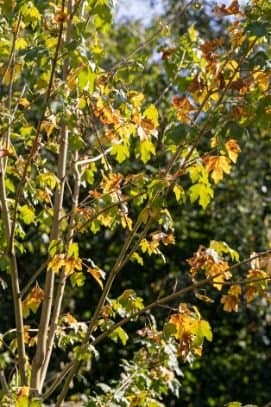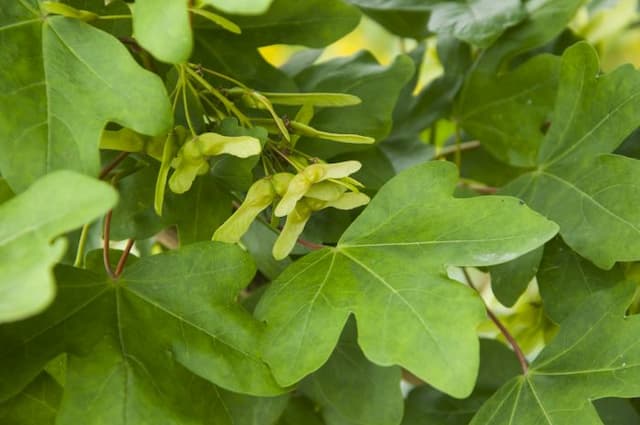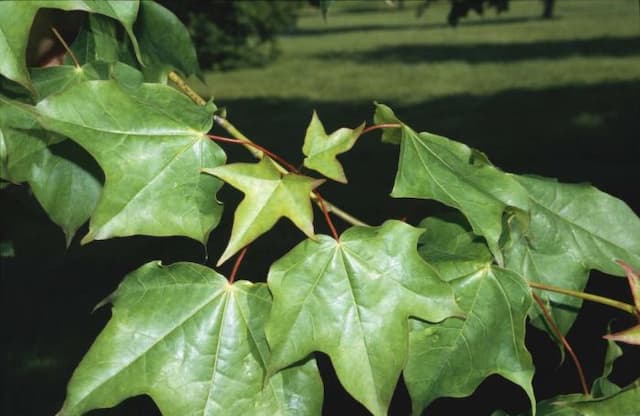Baumann's horse chestnut Aesculus hippocastanum 'Baumannii' (d)

ABOUT
'Baumannii' is a large, broad-crowned deciduous tree with large dark leaves of 5-7 leaflets. Flowers double, white with yellow marks that age to red. Fruit not developing
About this plant
 Names
NamesFamily
Sapindaceae.
Synonyms
Baumann's Horse Chestnut, Double-flowered Horse Chestnut, Sterile Horse Chestnut.
Common names
Aesculus hippocastanum 'Baumannii'
 Characteristics
CharacteristicsLife cycle
Perennials
Foliage type
Deciduous
Color of leaves
Green
Height
50 feet (15 meters)
Spread
40 feet (12 meters)
Plant type
Tree
Hardiness zones
6
Native area
Southeast Europe
Benefits
 General Benefits
General Benefits- Shade provider: The Horse Chestnut tree offers a large, dense canopy which is excellent for providing shade in parks, large gardens, and streets.
- Aesthetic appeal: With its attractive, double white flowers that appear in the spring, the tree adds ornamental value to landscapes.
- Wildlife support: The flowers provide a source of nectar and pollen for bees and other pollinating insects.
- Seasonal interest: The tree offers year-round visual interest with changing foliage; from fresh green leaves in spring to a rich, deep color in autumn before leaf drop.
- Urban tolerance: It is relatively tolerant to urban pollution, making it suitable for city planting and improving urban biodiversity.
- Drought resistance: Once established, it has a degree of resistance to drought, thus requiring less watering and maintenance in drier conditions.
- Low maintenance: Apart from occasional pruning and cleaning up of fallen conkers, it requires minimal care, making it a practical choice for public spaces and large landscapes.
 Medical Properties
Medical Properties- Anti-inflammatory: Horse Chestnut seed extract has been used to reduce inflammation and swelling.
- Venotonic: The seeds contain a compound called aescin which can help to strengthen the walls of veins, improving circulation and reducing varicose veins symptoms.
- Antiedematous: It may reduce fluid retention and swelling (edema), especially in the legs.
- Antioxidant: The plant contains antioxidants that can help in neutralizing free radicals in the body.
 Air-purifying Qualities
Air-purifying QualitiesThis plant is not specifically known for air purifying qualities.
 Other Uses
Other Uses- Aesculus hippocastanum 'Baumannii', commonly known as Horse Chestnut 'Baumannii', can be used as a natural leather conditioner due to the saponins found in the tree parts.
- The conkers (seeds) have historically been used for games, with children threading a string through the conker to play "Conkers," a traditional game in Britain.
- The powdered seeds were once used as a starch substitute in the laundering of clothes, providing a stiff finish to fabrics.
- Horse Chestnut 'Baumannii' wood, being soft and easy to work, has been used for carving and making lightweight furniture.
- Bio-dynamic agriculture may use preparations made from Horse Chestnut 'Baumannii' leaves to influence the growth of plants and composting processes.
- The tannic acid rich in the bark of the tree has been employed in tanning leather to enhance durability.
- The flowers have been used for their ornamental value to make natural confetti for celebrations such as weddings.
- Fresh Horse Chestnut 'Baumannii' leaves have been used to repel moths and other insects from wardrobes and drawers.
- Crushed seeds are sometimes spread in gardens and around plants as a natural deterrent against pests such as aphids.
- In rural crafts, the branches and seeds of the Horse Chestnut 'Baumannii' have been incorporated into rustic folk art and decorative objects.
Interesting Facts
 Feng Shui
Feng ShuiThe Horse Chestnut is not used in Feng Shui practice.
 Zodiac Sign Compitability
Zodiac Sign CompitabilityThe Horse Chestnut is not used in astrology practice.
 Plant Symbolism
Plant Symbolism- Strength and resilience: The Horse Chestnut tree, of which Aesculus hippocastanum 'Baumannii' is a cultivar, is often seen as a symbol of strength due to its robustness and sturdy trunk.
- Prosperity: In some cultures, the nuts of the Horse Chestnut tree are believed to bring good luck and wealth.
- Protection: The Horse Chestnut is also thought to have protective qualities, with some people carrying the conkers (seeds) as talismans to ward off negative energy.
- Endurance: Being a hardy tree that can live for many years, the Horse Chestnut symbolizes longevity and the ability to endure life's challenges.
- Healing: Due to the medicinal properties that have been associated with parts of the Horse Chestnut tree, it can also represent health and healing.
 Water
WaterThe Baumannii Horse Chestnut requires consistent moisture, especially during dry spells. During the growing season, it should be watered deeply at least once a week, with up to 20 gallons per application for an established tree. Younger trees should be given about 10 gallons each time, making sure to keep the soil moist but not waterlogged. During winter, reduce watering frequency as the tree enters dormancy but don't let the soil dry out completely. Water in the morning to allow moisture to soak in and decrease the likelihood of fungal diseases.
 Light
LightThe Baumannii Horse Chestnut thrives in full sun to partial shade. It will grow best if placed in a location where it receives at least four to six hours of direct sunlight daily. Avoid deep shade as it can inhibit the growth and flowering of the tree.
 Temperature
TemperatureThe Baumannii Horse Chestnut is tolerant of a wide range of temperatures, from winter lows of -20 degrees Fahrenheit to summer highs potentially above 100 degrees Fahrenheit. However, it will do best in an environment where the average temperature ranges from 50 to 75 degrees Fahrenheit. Freezing temperatures below -20 degrees Fahrenheit can damage young trees, but mature trees are quite cold hardy.
 Pruning
PruningPrune the Baumannii Horse Chestnut to maintain its shape and health, particularly by removing any dead or damaged branches. This is done best during its dormant period in late winter or early spring before the buds start to swell. Structural pruning every three to five years helps maintain the tree's form and prevents potential damage from weak branches.
 Cleaning
CleaningAs needed
 Soil
SoilThe Horse Chestnut 'Baumannii' prefers well-drained, fertile loam with a pH of 6.0-7.0. A mix containing garden soil, compost, and a small amount of sand or perlite is ideal to ensure good drainage and fertility.
 Repotting
RepottingHorse Chestnut 'Baumannii' is a large tree that does not require repotting as it is typically planted outdoors in the ground and not kept in containers.
 Humidity & Misting
Humidity & MistingHorse Chestnut 'Baumannii' is tolerant of a wide range of humidity levels and thrives in the ambient humidity found outdoors, which is where it is usually grown.
 Suitable locations
Suitable locationsIndoor
Not suitable for indoor growth, requires outdoor environment.
Outdoor
Plant in well-drained soil, full sun or partial shade, ample space.
Hardiness zone
4-7 USDA
 Life cycle
Life cycleThe common name for Aesculus hippocastanum 'Baumannii' is the double-flowered horse chestnut. The life cycle begins with seed germination which usually requires a period of cold stratification to break dormancy. After sprouting, the seedling grows into a sapling and gradually matures into a large deciduous tree. It produces characteristic palmate leaves and, unlike the typical horse chestnut, it bears double flowers that are sterile and thus does not produce viable seeds. The tree reaches flowering maturity within 10-20 years and can live for several decades, although it does not reproduce through seeds. Throughout its life cycle, the double-flowered horse chestnut goes through annual cycles of growth in spring, flowering in late spring, followed by leaf senescence and dormancy in autumn and winter.
 Propogation
PropogationPropogation time
Spring-early summer
The horse chestnut 'Baumannii' is generally propagated through grafting, which is the most popular method for this particular cultivar. Grafting involves joining the tissues of the 'Baumannii' to the rootstock of a compatible horse chestnut species. This is typically done in late winter or early spring when the plants are dormant. A common technique used is called bud grafting, where a bud from the 'Baumannii' is inserted under the bark of the rootstock. Care must be taken to ensure that the cambial layers of both the bud and rootstock touch, so that they can grow together. Once the graft union is complete, which may take several weeks, the bud will begin to grow into a new 'Baumannii' tree with the rootstock providing the necessary nutrients and support.







![Freeman maple [Autumn Blaze]](/_next/image?url=https%3A%2F%2Fplants-admin.emdemapps.com%2Fimages%2Fplants%2F%2Fimages%2F604b575b84d87.png&w=640&q=75)

